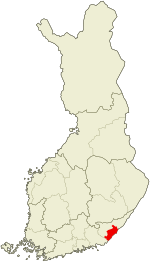Villmanstrand
|
Lappeenranta Villmanstrand |
||
|---|---|---|
| City | ||
| Lappeenrannan kaupunki | ||

Lappeenranta harbour
|
||
|
||
 Location of Lappeenranta in Finland |
||
| Coordinates: 61°04′N 028°11′E / 61.067°N 28.183°ECoordinates: 61°04′N 028°11′E / 61.067°N 28.183°E | ||
| Country |
|
|
| Region | South Karelia | |
| Sub-region | Lappeenranta sub-region | |
| Charter | 1649 | |
| Government | ||
| • City manager | Kimmo Jarva | |
| Area (2016-01-01) | ||
| • Total | 1,433.44 km2 (553.45 sq mi) | |
| • Land | 1,433.36 km2 (553.42 sq mi) | |
| • Water | 290.14 km2 (112.02 sq mi) | |
| Area rank | 47th largest in Finland | |
| Population (2017-08-31) | ||
| • Total | 72,685 | |
| • Rank | 13th largest in Finland | |
| • Density | 50.71/km2 (131.3/sq mi) | |
| Population by native language | ||
| • Finnish | 95.9% (official) | |
| • Swedish | 0.1% | |
| • Others | 4% | |
| Population by age | ||
| • 0 to 14 | 15.1% | |
| • 15 to 64 | 67% | |
| • 65 or older | 17.9% | |
| Time zone | EET (UTC+2) | |
| • Summer (DST) | EEST (UTC+3) | |
| Municipal tax rate | 19.5% | |
| Urbanisation | 90.4% | |
| Unemployment rate | 14.7% | |
| Climate | Dfc | |
| Website | www.lappeenranta.fi | |
Lappeenranta (Swedish: Villmanstrand) is a city and municipality situated on the shore of the lake Saimaa in southeastern Finland, about 30 kilometres (19 miles) from the Russian border. It belongs to the region of South Karelia. With approximately 73,000 inhabitants (31 August 2017) Lappeenranta is the 13th largest city in Finland. The neighboring municipality of Joutseno was consolidated with Lappeenranta on January 1, 2009, and the neighboring municipality of Ylämaa on January 1, 2010. Lappeenranta is known as an international university city in Finland with Lappeenranta University of Technology and Saimaa University of Applied Sciences which together have approximately 13,000 students from 68 countries. Lappeenranta is also a commercial centre of South-East Finland and the meeting point of the EU and Russia, 215 km from both Helsinki and St. Petersburg. Location on the southern shore of Lake Saimaa makes the city the region’s centre for tourism. Lappeenranta is the second most visited city by Russian tourists in Finland after Helsinki and it competes with Helsinki for the largest share of tax-free sales in Finland. Lappeenranta is a model for renewable energies and a clean living environment. Lappeenranta was the only Finnish city among the 14 finalists in the international Earth Hour City Challenge 2014, organized by WWF.
Lappeenranta was originally formed around a headland pointing to lake Saimaa. In the 16th century, the market place moved from Lappee's old centre Kauskila to the current fortress headland. The first mention of Lapwes, as it was called, is in a privilege charter from 1542 that subjugated the market place under Viborg's authority.
The town was chartered in 1649 by Queen Christina of Sweden, legitimizing the trade in the then popular marketplace of Lapvesi. However, the parliamentary privilege charter and the coat of arms were attested in 1652 after the town layout by Erik Aspegren was affirmed. At the time, Lappeenranta was an important port for tar.
...
Wikipedia

